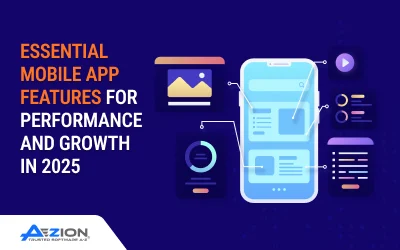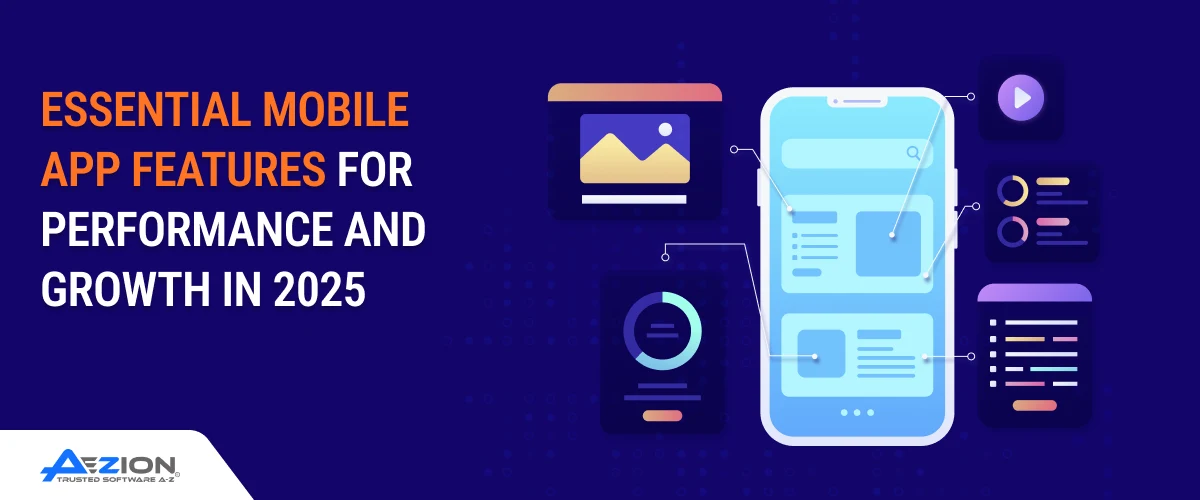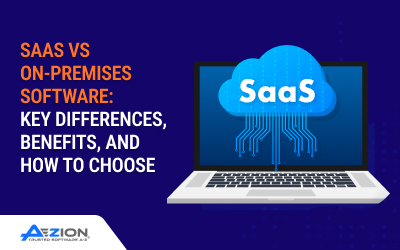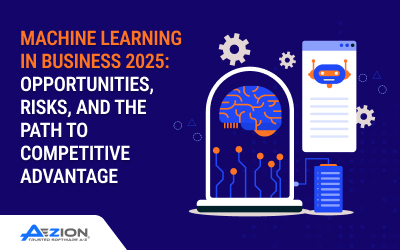Summary
Well-structured mobile app features determine how an application performs under real-world conditions. Each feature contributes to speed, stability, and usability, from managing server calls to supporting device compatibility. As users demand faster response times and tailored experiences, apps must have features supporting front-end logic and backend resilience.
Introduction
Modern users expect mobile applications to function quickly, respond accurately, and deliver personalized value with minimal friction. The mobile app features selected during development directly impact these outcomes. Each function, whether related to interaction, performance, or data handling, must be carefully mapped to meet user behavior, system requirements, and evolving digital expectations.
Why Mobile App Features Matter
Every element inside a mobile app contributes to how it performs, scales, and connects with users. Features aren’t just about what an app does they define how well it responds to demand, handles data, and supports future growth.
Influence on User Experience and Retention
When users encounter slow response times, cluttered navigation, or missing core functions, abandonment rates rise. Prioritizing relevant features of mobile applications improves engagement, session duration, and retention by aligning functionality with user habits and device behavior.
Role in Competitive Differentiation
What sets one app apart from another often comes down to feature depth and execution. While competitors may offer similar services, apps that deliver faster load times, intuitive gestures, or smarter personalization tend to win user preference. Strong mobile app features elevate the product from being functional to becoming the preferred choice.
Impact on App Performance and Scalability
An app’s technical architecture relies heavily on how its features interact with backend systems. Poorly designed components increase load, consume memory, and restrict growth. The characteristics of mobile applications must be planned to support concurrency, minimal API overhead, and consistent performance across devices as user demand scales over time.
Must-Have Mobile App Features In 2025
The selection of core functionalities determines how an app performs under real usage. Each feature must serve a purpose balancing front-end simplicity with technical depth. Below is a breakdown of the most relevant mobile app features expected to define performance, usability, and scalability in 2025.
Intuitive User Interface
Clear visual hierarchies, responsive elements, and minimal tap paths form the basis of a good interface. When the design guides users without forcing them to think, it reduces friction. A smooth UI remains one of the most essential mobile app features for long-term engagement.
Fast Onboarding & User Registration
First impressions begin with how quickly users can access the core experience. Single sign-on, guest entry, or auto-fill options reduce friction. This feature of mobile applications sets the tone for usability and directly affects drop-off rates during initial interaction.
Push Notifications
Relevant alerts delivered at the right moment improve engagement without overwhelming the user. Whether transactional or behavior-triggered, this characteristic of mobile applications drives retention by creating timely touchpoints that reconnect users with in-app value or encourage them to complete pending actions.
In-App Messaging or Chat
Real-time communication inside the app simplifies support, boosts user trust, and strengthens engagement loops. This mobile app feature creates direct interaction channels for resolving issues, sharing updates, or enabling social functions without pushing users to leave the app environment.
Advanced Search and Filters
When users need to locate content quickly, search precision matters. Autocomplete, tagging, and dynamic filters enhance navigation. Among the features of mobile applications, this one directly supports discoverability especially in content-heavy apps where relevance and retrieval speed affect user satisfaction.
Personalization and Recommendations
User behavior, preferences, and interaction history guide content delivery in real time. This mobile app feature adapts layouts, suggestions, and promotions to match intent, helping apps stay contextually relevant and reduce churn through more targeted, data-informed experiences.
Offline Functionality
Apps that maintain usability without network access offer stronger reliability. Caching, local storage, and sync-on-reconnect improve accessibility in low-bandwidth environments. This feature of mobile applications supports consistent usage in travel, remote areas, or on-the-go scenarios where connectivity isn’t guaranteed.
In-App Payments & Wallet Integration
Built-in payment flows reduce drop-offs during transactions. Whether it’s card processing, UPI, or wallet options, this mobile app feature simplifies checkout, boosts conversion rates, and supports secure financial interactions without redirecting users outside the app environment.
Voice Search or Commands
Voice-based interaction enhances accessibility and speed, particularly for users on the move. This characteristic of mobile applications supports hands-free navigation, quick queries, and task execution making the app more adaptable to diverse user contexts and device interactions.
Location-based Services
GPS-driven features support local discovery, tracking, and proximity-based actions. From ride-hailing to retail offers, this mobile app feature tailors the user experience based on geographic context, enabling smarter content delivery and operational accuracy in real-world environments.
App Analytics and User Tracking
Understanding how users move through the app is essential for iteration. Event tracking, heatmaps, and behavior flows offer insights into drop-offs, retention, and usage frequency. This feature of mobile applications supports data-backed decisions and long-term performance tuning.
Social Media Integration
Connecting with other platforms like social media and search engines like LinkedIn, Instagram, Bing, or Google simplifies login, allows for content sharing, and supports social proof. This comprehensive mobile app feature increases user reach while lowering friction, especially during registration or content amplification processes.
Multi-Device Sync
Consistency of your mobile application across phones, tablets, and desktops requires real-time data synchronization. Whether users switch devices mid-task or resume later, this characteristic of mobile applications ensures continuity, session stability, and data preservation throughout distributed usage.
Biometric Login (Face ID/Fingerprint)
In the new-age tech era security meets convenience through biometric access. By using native device capabilities for authentication, this particular mobile app feature minimizes friction while improving data protection particularly in apps dealing with payments, health records, or user identity verification.
Data Encryption and Privacy Controls
Protecting user data requires more than compliance it demands proactive design. End-to-end encryption, permission prompts, and user-managed settings make this feature of mobile applications essential for safeguarding sensitive information across communication, storage, and access points.
AI & ML Capabilities (e.g., Smart Suggestions)ē
Predictive logic enhances engagement by anticipating user intent. From product recommendations to auto-categorization, this mobile app feature applies machine learning to personalize experiences, reduce input effort, and improve decision-making within the app environment.
Dark Mode
Mobile apps have gone beyond aesthetics today and dark mode reduces eye strain and conserves battery on OLED screens. As a growing user preference, this feature of mobile applications supports accessibility and offers a visually adaptive experience based on ambient conditions or user choice.
Accessibility Features
Inclusive design expands usability across different abilities. Features like screen reader compatibility, adjustable text size, and voice control make this characteristic of mobile applications essential for supporting diverse user needs and complying with accessibility standards.
Cloud Backup and Data Sync
You loss prevention and device flexibility depend on real-time backups and synchronization mechanisms within your app. This mobile app feature preserves user progress, preferences, and activity history by connecting app data with secure cloud infrastructure across sessions and devices.
Ratings & Feedback Mechanism
Capturing user sentiment in-app reduces churn risks and guides future updates based on user preferences and behavior. Whether through star ratings, quick surveys, or open comments, this feature of mobile applications supports direct insight collection without forcing users to exit the environment.
Real-time Updates and Sync
The real-time live content delivery keeps data consistent across users and sessions. In collaborative or transactional applications, this mobile app feature supports accurate syncing of inputs, status changes, and notifications without manual refreshes or background delays improving the overall user interaction with the app.
Crash Reporting and Error Tracking
Diagnosing runtime issues requires structured visibility. Integrated crash logs, stack traces, and real-time alerts make this feature of mobile applications critical for reducing downtime, improving code stability, and resolving errors before they affect user experience.
Customizable User Settings
Allowing users the option to adjust notifications, themes, privacy options, and preferences gives them control over the mobile experience. This mobile application feature improves satisfaction by aligning application behavior with individual usage patterns and comfort levels.
Multi-language Support
Global accessibility depends on language flexibility. Supporting multiple languages through localized content, formatting, and UI text allows this feature of mobile applications to cater to wider demographics while improving usability for non-native speakers.
Features Based on App Type
While some mobile app functions apply across categories, others must adapt to industry-specific use cases. The specific features of mobile applications vary depending on factors like the audience, data requirements, and engagement model of each app type.
eCommerce Apps
Inventory visibility, personalized offers, one-tap checkout, and real-time order tracking define successful retail apps. These mobile app features support purchase completion, reduce cart abandonment, and improve post-sale engagement through status updates and support access.
Healthcare Apps
HIPAA-compliant storage, appointment booking, symptom tracking, and teleconsultation interfaces are core features of mobile applications in healthcare. These tools support patient monitoring, clinical communication, and secure access to medical records across devices.
EdTech Apps
Interactive lessons, progress tracking, live classes, and quiz modules shape learning experiences. These characteristics of mobile applications enhance engagement, adapt to varied learning speeds, and support both synchronous and asynchronous education delivery.
SaaS Business Apps
Role-based access or RBAC, data dashboards, collaboration tools, and third-party integrations are essential sets for most of the mobile app features in SaaS environments. These elements support workflow management, analytics, and operational continuity for distributed business users.
Gaming and Entertainment Apps
Low-latency graphics, in-app purchases, reward systems, and social sharing define interactive media apps. These features of mobile applications drive retention, increase session time, and support monetization through dynamic, user-driven content engagement.
Common Mistakes to Avoid While Adding Features
Not every feature within your mobile app improves usability. In fact, poor decisions during planning or development can slow the app, confuse users, or bloat the interface. Below are some missteps often made while defining mobile app features.
Overloading with Too Many Features
Cramming every idea into one app leads to cluttered interfaces and higher crash risk. This mistake dilutes core functionality and creates friction. Instead of adding more mobile app features, focus on prioritizing what solves the most relevant user problems.
Ignoring Platform-Specific Guidelines
Failing to align with Android or iOS standards results in inconsistent behavior, broken navigation, or rejected submissions. Every feature of mobile applications should respect native UI conventions, gesture controls, and system requirements defined by the target platform.
Poor Feature-User Journey Mapping
Features that interrupt, confuse, or fail to align with user goals often go unused. Without proper mapping to user flows, even advanced mobile app features create friction. Clarity in placement and timing is key to functional adoption.
How to Prioritize Features in App Development
Every feature comes with a cost time, performance, or complexity. To deliver value early and avoid waste, teams must assess which mobile app features offer the most impact relative to effort, relevance, and scalability.
Understand User Needs
User feedback, behavioral data, and contextual pain points reveal what matters most. Instead of guessing, use research to define which features of mobile applications align with real usage patterns and solve immediate problems with minimal complexity.
Use MoSCoW or RICE Framework
Structured prioritization helps avoid bias. These models assign value to each mobile app feature based on reach, effort, impact, or urgency ensuring that the most strategic functionalities are delivered first without losing sight of long-term goals.
Validate with MVP Testing
Launching with a minimal set reveals how users interact in real conditions. MVP testing helps confirm which characteristics of mobile applications work as intended and which ones need refinement before scaling development further.
Conclusion
Choosing the right mobile app features is essential to balancing usability, scalability, and long-term value. Whether supporting personalization, performance, or security, each function must serve a purpose. The most impactful features of mobile applications not only meet user expectations but also reinforce the app’s ability to grow, adapt, and deliver consistent experiences. If you are a business owner you can also get in touch with an leading custom software development company to help you with the right approach ith the right set of mobile app features and get started today!.
FAQs
What are the top features every mobile app should have?
Core features include smooth navigation, secure login, offline access, analytics, and user feedback tools. These functions create the foundation for engagement, usability, and long-term retention across devices.
How do I decide which features my app should include?
Start by understanding user goals, use cases, and technical constraints. Prioritize features based on value, effort, and scalability using models like MoSCoW or RICE before committing to full-scale development.
What features increase user engagement the most?
Push notifications, in-app rewards, personalized content, and real-time updates tend to drive stronger engagement. These features encourage users to return, interact frequently, and stay connected to the app’s value.
Are there features every app should avoid?
Avoid unnecessary complexity, duplicate functions, and intrusive prompts. Features that confuse users, slow down the experience, or serve no measurable purpose often reduce satisfaction and increase abandonment rates.
How often should app features be updated?
Feature updates should align with user feedback, usage data, and platform changes. Regular improvements every 6–8 weeks help maintain performance, address issues, and adapt to evolving user expectations.




